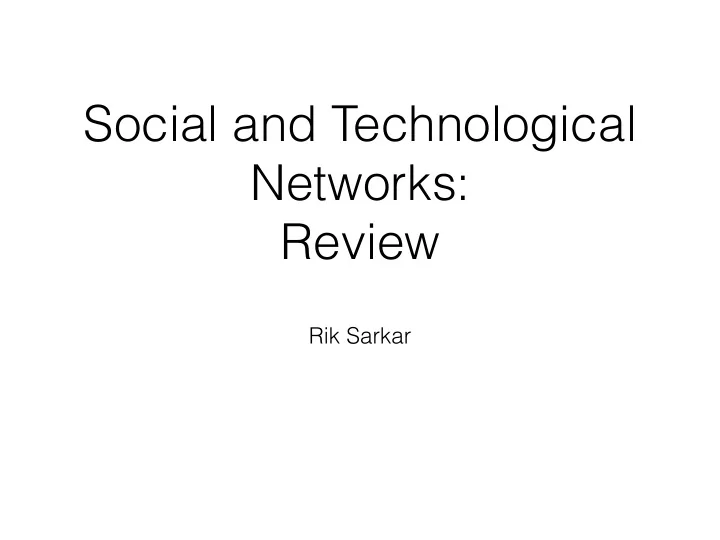

Social and Technological Networks: Review Rik Sarkar
Networks • Networks/graphs are fundamental in computer science • And becoming more important • As systems, people, computation become more interconnected
Why study networks • We need network analysis for a lot of big data analysis • Since many of them are networks • Or about processes operating on networks • It is possible to apply network analysis even when the data is not about a network • Eg. image analysis, text analysis… • Clustering is basically community detection…
Today • Project: follow up discussion • Lectures and topics: follow up discussion • What to study for exam • What to expect in exam
Project • The purpose: • It was about the experience, not memorizing/coding/marks • Learn to do large projects • Think of some original ideas, try some programming… • Use your freedom to do what you like � • What did you think?
• If you thought it was interesting, and you would like to do similar things with more time • Consider applying for a PhD • Only way you get to work on your own ideas • You get to develop and learn new, cutting edge ideas that most people do not know
• Apply in december/january • Make the decision to accept/reject when you get the offer later • Undergraduates can apply. MS not necessary.
Projects • Some of the challenges • Short time • Description vague, expectations not clear • You need something “new” not clear what • These are common in all interesting real-world tasks • In industrial innovation centers, you have similar jobs: • “Do something valuable”
Common mistake: The planning fallacy • Underestimate the time things would take! • Spend a lot of time planning/thinking
Suggestions • When making a plan, also think if you have time for it • Don’t try for a perfect or best possible plan • Make a decent plan that seems workable and start working on it • Add new ideas as you go • Change plans as needed • When something does not work as expected • If time feels short, adjust plan. Think: can you do a shorter version? • What is the important element that you can do in the short time? • What is an alternative that still gets you “some” valuable result, but different from what you were thinking?
Lectures • The purpose: • Show you some interesting ideas • How mix of theory and applications are important • Give you basics of networks • You can now go and read more… � • What did you think?
In the course, We saw… • Network properties/measures • Diameter, CC, expansion…. • Random graphs: Erdos renyi model • Probability of isolated vertices • Threshold phenomenon at p = (ln n)/n • Clustering, cycles etc..
We saw… • Power law networks • Generating models • Small worlds & generating models • Web graphs • Important nodes: HITS & pagerank, analysis • Spectral graph theory and spectral gap
We saw… • Tie strengths, bridges, social capital, homophily… • triadic closure etc.. • Community detection, modularity, correlation clustering • Cascades & thresholds • Viral marketing and maximizing spread • Submodularity: Coverage, diminishing marginal returns
We saw • Greedy Approximation of submodular maximization • Epidemics, diffusion and gossip • Treeness and curvature of metrics: study of internet • A hyperbolic generating model • Produces power law networks with community structure • Friendship paradox, finding romantic pairs
For exam • Everything on slides except when mentioned otherwise • Everything in “Reading” list for the lecture • Everything in lecture notes unless mentioned otherwise • Recommended: • Material in additional reading • Relevant chapters in Kleinberg & Easley 2010, and Kempe 2011.
What is not in exam • Hyperbolic geometry • Network flows • NP-completeness • Gossip algorithms
Notes and slides • Notes and slides being updated • Please always use the online & refreshed web page • Do not use an old version • Please let me know any errors/inconsistencies you notice • I will update you when they are mostly updated or when there is any major change • December visiting exam: Everything updated till end of next week
Exam • Answer 2 questions out of 3 • Question 1 compulsory • Answer one out of 2 and 3
Questions • Define property/measure X. • For a given graph in Figure, compute X • eg. CC/betweenness of each node, of the graph, diameter of the graph, matrix A or L etc.. • For a description of a graph, show that it must have the following property …. • Examples in exercises • If a graph obtained from source Y has properties a, b, c • What would that imply about the source Y?
Questions • Given a problem such as … • How would you solve this? What algorithm will you use? Justify your answer. • What are the advantages/disadvantages of using X in problem setup Y? • Kleinberg and Easley 2010 has questions after each chapter. • Some additional questions etc will be put up after lecture notes etc.
Recommend
More recommend